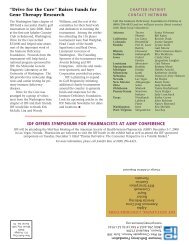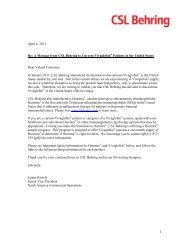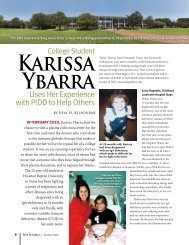DiGeorge Syndrome - Immune Deficiency Foundation
DiGeorge Syndrome - Immune Deficiency Foundation
DiGeorge Syndrome - Immune Deficiency Foundation
Create successful ePaper yourself
Turn your PDF publications into a flip-book with our unique Google optimized e-Paper software.
Chapter 13<strong>DiGeorge</strong> <strong>Syndrome</strong>
<strong>DiGeorge</strong> <strong>Syndrome</strong><strong>DiGeorge</strong> <strong>Syndrome</strong> is a primary immunodeficiency disease caused byabnormal migration and development of certain cells and tissues duringfetal development. As part of the developmental defect, the thymusgland may be affected and T-lymphocyte production may be impaired,resulting in low T-lymphocyte numbers and frequent infections.Definition of <strong>DiGeorge</strong> <strong>Syndrome</strong><strong>DiGeorge</strong> <strong>Syndrome</strong> (DGS) is a primaryimmunodeficiency, often but not always, characterizedby cellular (T-cell) deficiency, characteristic facies,congenital heart disease and hypocalcemia. DGS iscaused by abnormal formation of certain tissuesduring fetal development. During fetal development,various tissues and organs often arise from a singlegroup of embryonic cells. Although the tissues andorgans that ultimately develop from this group ofembryonic cells may appear to be unrelated in thefully formed child, they do have a similar origin.Approximately 90% of patients with DGS have a smalldeletion in chromosome number 22 at position22q11.2. Thus another name for this syndrome is the22q11.2 deletion syndrome. Other names includevelocardiofacial syndrome and conotruncal anomalyface syndrome.While the genetic defect is the same in the majority ofpatients with DGS, they all do not present in the sameway. For example, some patients with DGS havesevere cardiac anomalies; some have none at all.Some have major learning disabilities; others havenone. This is called phenotypic variability. There iswide phenotypic variability in patients with DGS.Patients with DGS may have any or all of the following:Unusual facial appearance - Features may include anunderdeveloped chin, eyes with heavy eyelids, ears thatare rotated back and small upper portions of their earlobes. These facial characteristics vary greatly fromperson to person and may not be prominent in manypatients.Heart defects - These include a variety of heart (orcardiac) defects. The defects usually involve the aortaand the part of the heart from which the aorta develops.In some patients, heart defects may be very mild orabsent.Thymus gland abnormalities - The thymus is crucial inthe development of the cellular (T-cell) immune system.It is normally located in the upper area of the front ofthe chest behind the breastbone. The thymus begins itsdevelopment high in the neck during the first threemonths of fetal development. As the thymus maturesand gets bigger, it drops down into the chest to itsultimate location under the breastbone and in front ofthe heart.The thymus controls the development and maturationof one kind of lymphocyte, the T-lymphocyte, “T”for “Thymus.” (See chapter titled “The <strong>Immune</strong>System and Primary <strong>Immune</strong> <strong>Deficiency</strong> Diseases.”)The size of the thymus affects the number ofT-lymphocytes that can develop. Patients with a smallthymus produce fewer T-lymphocytes than those witha normally sized thymus. T-lymphocytes are essentialfor protection against infections. Some T-lymphocytes,the cytotoxic T-lymphocytes, directly kill viruses.T-lymphocytes also help B-lymphocytes to develop into73 | IDF Patient & Family Handbook
<strong>DiGeorge</strong> <strong>Syndrome</strong>(Definition of <strong>DiGeorge</strong> <strong>Syndrome</strong> continued)antibody producing plasma cells. Patients with DGSmay have poor T-cell production compared to theirpeers, and as a result, have an increased susceptibilityto viral, fungal and bacterial infections.As with the other defects in DGS, the T-lymphocytedefect varies from patient to patient. In a very smallnumber of patients with DGS the thymus is completelyabsent, so the number of T-cells is severely low. Thesepatients require prompt medical attention since theyare severely immunocompromised. The majority ofpatients with DGS have less severe or milddeficiencies.Autoimmunity - Patients with DGS developautoimmune disease at a rate that is higher than inthe general population. Autoimmune disease occurswhen the immune system inappropriately attacks itsown body. (See chapter titled “Autoimmunity inPrimary Immunodeficiency.”) It is not known why thishappens in people with T-lymphocyte problems. Themost common autoimmune diseases in DGS areidiopathic thrombocytopenia purpura (antibodiesagainst platelets), autoimmune hemolytic anemia(antibodies against red blood cells), autoimmunearthritis, and autoimmune disease of the thyroid gland.Parathyroid gland abnormalities - These glands maybe underdeveloped in patients with DGS, causinghypoparathyroidism. The parathyroids are small glandsfound in the front of the neck near the thyroid gland,hence the name “parathyroid.” They function tocontrol the normal metabolism and blood levels ofcalcium. People with DGS may have troublemaintaining normal levels of calcium, and this maycause seizures (convulsions). In some cases, theparathyroid abnormality is not present at all, relativelymild or only a problem during times of stress such assevere illness or surgery. The parathyroid defect oftenbecomes less severe over time.Miscellaneous clinical features - Patients with DGSmay have a variety of other developmentalabnormalities including cleft palate, poor function ofthe palate, delayed acquisition of speech and difficultyin feeding and swallowing. In addition, some patientshave learning disabilities, behavioral problems,psychiatric disorders and hyperactivity. For exampleschizophrenia occurs at a higher rate in patients withDGS compared to the rate in the general population.Diagnosis of <strong>DiGeorge</strong> <strong>Syndrome</strong>The diagnosis of DGS is made on the basis of signs andsymptoms that are present at birth, or develop soonafter birth, along with confirmatory genetic testing. Someinfants may have facial features that are characteristic ofDGS. Affected infants may also show signs of low bloodcalcium levels as a result of hypoparathyroidism. Thismay show up as low blood calcium on a routine bloodtest, or the infant may be “jittery” or have seizures as aresult of the low calcium.Affected infants may also show signs and symptoms ofa heart defect. These may include a heart murmur thatis detected on a routine physical exam. They may showsigns of heart failure, or they may have low oxygencontent of their arterial blood and appear “blue” orcyanotic. Affected infants may also develop infectionbecause of their low T-lymphocyte levels.In some children, all of the classical features arepresent and the diagnosis of DGS is made very early. InIDF Patient & Family Handbook | 74
<strong>DiGeorge</strong> <strong>Syndrome</strong>Management of <strong>DiGeorge</strong> <strong>Syndrome</strong>Immunologic care for patients with DGS includesmonitoring the overall immune system including thenumbers and function of T-lymphocytes. Patients whohave initially been deemed immunocompetent but thendevelop frequent, severe or unusual infections shouldhave their immune system reevaluated.Between 1-2% of patients with DGS completely lackT-cells. This is a serious, potentially fatal, condition thatis similar to Severe Combined <strong>Immune</strong> <strong>Deficiency</strong>(See chapter “Severe Combined <strong>Immune</strong> <strong>Deficiency</strong>and Combined <strong>Immune</strong> <strong>Deficiency</strong>.”) This issometimes called “complete” <strong>DiGeorge</strong> syndrome and isusually associated with severe low blood calciumcausing seizures. In this situation, T-cells must bereconstituted for the infant to survive. This can beachieved with a thymus transplant (available only on aresearch basis) or by stem cell transplantation.In some patients with DGS, the T-lymphocyte defect issignificant enough to cause the B-lymphocytes to fail tomake sufficient antibodies. This occurs becauseantibodies are produced by B-lymphocytes under thedirection of a specific subset of T-lymphocytes.(See chapter titled “The <strong>Immune</strong> System and PrimaryImmunodeficiency.”) When the B-cells are affected, theresult is simply a delay in the production of antibodies.Immunoglobulin replacement therapy is sometimesrequired.Expectations for Patients with <strong>DiGeorge</strong> <strong>Syndrome</strong>The outlook for people with DGS depends on thefunction of each affected organ system. The severity ofheart disease is usually the most important determiningfactor. With the improvements made in cardiac surgeryand management of immunodeficiency, the infantmortality rate in DGS is estimated to be relatively low atapproximately 4%. Early diagnosis is important andoptimal management of patients with DGS requires amultidisciplinary approach including an immunologist aspart of the team of specialists.IDF Patient & Family Handbook | 76
















